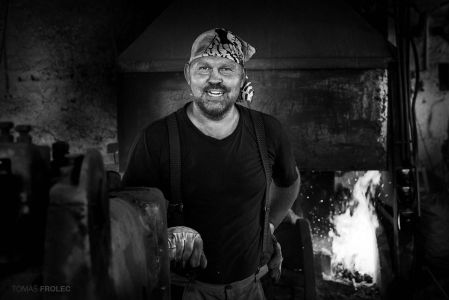Defects arising during the folding process
Several types of defects can occur during the folding process. The most common is ware, an unwelded layer in a block of steel. This is most often due to poorly cleaned scaling of the welded surfaces. Scales are formed by oxidation of the heated surface and appear as a thin layer of oxides on it. Some of the scale falls off during forging, pulling out the packet before chopping and folding. Some of the thicker scales then need to be removed mechanically or by water (mizuuchi) when water is sprayed under the packet during forging. This cools and loosens the thin layer from the steel, and the steam generated by the hammer blow between the anvil and the hot packet breaks off the scale. Another option is to use flux (Borax) which melts the scale layer.
The layer is also opened when the packet or the blade rod is pulled out. Especially at lower temperatures and when forging in height, when the impact comes perpendicular to the lay-up.
When the packet is reworked, it can be repaired by filling the spot with flux and re-welding (forging) the spot with the defect. For small defects, it is better to grind off the defect.
Another flaw is Fukure. It is a bubble, air sealed between layers. This shows up first as a darker spot when the packet is forged. When the block is pulled out and the bubble wall is thinned sufficiently, the air expands when heated and can form a bulge, a bubble, on the steel. Either forms similar to a ware when the surface is not sufficiently descaled, where the oxides in the surface prevent the surfaces in the area from welding together and the material fuses in its surroundings. The other possibility is air confinement between the surfaces, where the packet is welded at the edges and air is unable to escape. This can be avoided by thoroughly scanning the packet after chopping and folding the packet before heating it further to welding temperature. Next, when welding the packet, proceed /forge from the fold to the open face of the packet to displace any residual air.
If the fukure occurs during the packet fitting, it is sufficient to cut through the spot with a chisel and thus allow the sealed air to escape. The spot is repaired during the next welding. If the fukure appears during the pulling of the bar and is small, it can be sanded off. However, this means taking material to deeper layers. This may affect the jigane at the repair site and if the blade is shingane, it may break through to the core. In this case, it is better to chop the rod and use it to make smaller blades.
Shinie. They appear as cracks on the edge of the packet or bar. Similar cracks occur when forging high carbon steels or when forging modern and alloy steels at high temperatures (e.g. in the production of welded damascus). When using traditional steels the reasons are the high C content at the beginning of the forging process. Repeated folding of the packet will reduce the C content and the material will stop tearing. When using high C content steel as input material, it is not advisable to encase the packet in ash during welding. This prevents the C from burning out of the steel.
If the tearing of the steel occurs after several folding operations and the grain in the cracks is coarse, similar to sand, this may be due to the presence of undesirable elements (alloys) in the steel. These may already be present on entry (unsuitable ore, contamination by the reducing environment of the furnace) or the chemical composition may be affected by unsuitable coal. For example, oak coal contains sulphur and contaminates the steel during reloading. This becomes completely unusable with more reloading.
With enough reloading, typically 4-5 will homogenize the traditional steel and reduce the C content. The steel becomes more malleable. It is easier to draw and is softer at the fold. However, if the folding is continued more than 10-12 times, the material starts to tear again at the edges. Then the next time it is folded, it degrades very quickly and the cracks get bigger. This unwanted effect is enhanced by wrapping in ash. Basically, this steel is only malleable at lower temperatures. When the bar is pulled out, small cracks form on the edges and edges of the bar. They can be ground off. However, it is questionable whether such steel should be used at all for a sword.
I believe that the ideal number of folding is 8-10 plus the subsequent joining of the steels during the construction of the packet (san mai,kobuse). When chopping and bending the packet, the behaviour of the steel at the chopping point should be carefully observed. Here you can see how the quality of the steel changes. When the packing is smooth and the bend does not tear, there is no separation of layers, the steel is ready for use. With further folding, the bending point is prone to tearing. The viscous elastic material becomes brittle. It is better to stop translating at this stage. (I am not concerned with changes in C content due to overfolding, where excessive overfolding will decarburize the steel and make it unforgeable).
